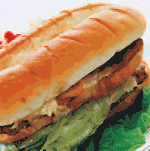THE BUSINESS OF LUNCH

THE BUSINESS OF LUNCH
BY DANIEL BROCKLEY
A person might think that when they’ve been doing something since childhood they would have it pretty much down pat. Breathing? Check — no problem. Walking? With a few notably humorous exceptions, it’s under control. Eating? Well, there’s where things get a little tricky. Beyond the days of the high chair, the do’s and don’ts of dining in polite society are numerous and confusing ... and when you add an element such as business into the mix, it’s unwise to simply leave success to chance.
The business lunch is a crucial component to American corporate culture, from entrepreneurs trying to get an idea off the ground to CEOs of Fortune 500 companies making company-wide policy changes.
Pulling off a successful business lunch takes, above all, grace. It requires the ability to remain attuned to both the social and professional, even when — as sometimes happens with well-established relationships — that line becomes blurred.
In his book, “Networking Smart,” Wayne Baker puts it this way: “At the heart of relationship-marketing is a great social truth: Business and personal ties become intermixed in long-term relationships.” And nowhere is this more true than with the corporate identity marketplace.
The Basics
Although the dance of a successful business lunch can be complicated, there are a few simple steps one can do to bolster the chance of a positive experience:
Choose the right venue. When selecting a restaurant, take your guest’s personality and tastes into account. Does he tend to be casual or formal? Will he be impressed by a fancy restaurant or will it just make him uncomfortable? Also take into consideration that you’ll want to be able to talk comfortably at the restaurant. Some swanky, highly praised restaurants can be too noisy and frenetic for easy conversation. If you don’t know your guest(s), choose a nice, conservative location, and if you aren’t familiar with restaurants in the area, ask a trusted associate for recommendations.
Dress appropriately to the venue you choose. If you have any question about what to wear, error on the side of formal. Your guest won’t fault you for showing you care. It’s flattering, and a sign of a true professional.Arrive on time. Showing up late says a lot about you — none of it good. Your guest is busy; respect his schedule.
Be good to the wait staff. This is something that’s said over and over in business etiquette books, and for good reason. The way you treat those waiting on you will be taken as a true test of your personality by the person sitting across from you at the table. Be kind and gracious. Be easy to get along with. Who doesn’t want that in a business partner?
Be careful with alcohol. Follow the other person’s lead. If he has a glass of wine, then that signals it’s fine for you to do so. But for Pete’s sake, don’t drink too much — generally no more than a glass. And if it’s not possible to take the other person’s lead, just abstain. Nobody will think less of you for not having a glass of wine with your meal.
Even though the purpose of your lunch may be business, it’s important to ease into things. Unless your guest launches into it first, save the business portion of your discussion until at least after you’ve ordered. It will help put both you and your guest at ease.
Steer clear of food that has a mind of its own. “Ignore your craving for the barbecue pork sandwich,” says the Creative Group, a high-tech placement agency. “By sticking to easy-to-eat items, you’ll save yourself the embarrassment of sauce dripping down your shirt.”
Beyond the Basics
“A meeting is worthwhile only if it achieves positive, tangible results,” says Michael Thomsett in “Little Black Book of Meetings.” Okay, that may be a little overzealous when it comes to your everyday business lunch, but results should still be taken into account. Plot out your objectives before you go into a business lunch. What do you want to get out of the meeting? If your answer is, “build a relationship” that’s great, but you need to be more specific. In a perfect world, what will the results of this interaction be in a week, a month, a year ... five years? And what steps can you take today that will make those things happen?
If you were facilitating a board meeting, you wouldn’t think about showing up without an agenda. Now, of course, you aren’t going to pull out an actual agenda at your lunch, but it’s a good exercise to plot out your ideal business lunch agenda before hand. You need to be flexible and deviate from it whenever called for, but making an agenda can help solidify your goals.
“People who network smart see relationships as the essential way to get jobs done,” says Wayne Baker.
Remember, relationships are long-term investments, and the business lunch is just one step in building a successful partnership.
It’s not just about commerce. It’s about people.
Daniel Brockley is the copywriter for SanMar Corp. Prior to working in wholesale apparel, Brockley managed marketing communications and public relations at REM Eyewear and AlexanderOgilvy, working with high-profile brands ranging from B2B and technology to fashion.

0 Comments:
Post a Comment
<< Home